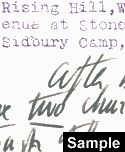
This short paper on a possible sun alignment in the Malvern Hills was included by Watkins in his letter to Alfred Pope. It is duplicated in purple ink on a foolscap sheet. Watkins made some handwritten additions, which are here highlighted in yellow.
The text is almost the same as the description in The Old Straight Track, pp. 100–102, but there are some differences: e.g. we learn that the “victim” in the photo (Fig. 101 of The Old Straight Track) was a Mr. Bennett rather than Watkins’s usual helper W.H. (Bill) McKaig.
ALIGNMENT OF GIANT’S CAVE AND SACRIFICIAL STONE
MALVERN HILLS
by Alfred Watkins.
I first visited this cave about 45 years ago and was puzzled at the shallow cut panel at its back, but had no suspicion as to its pre-historic origin. It lies at the top of the Herefordshire side of the ridge, near the Herefordshire Beacon on its Eastnor side. Below it is a large rough igneous stone, which appears to be a natural outcrop, but might be detatched. This is referred to as the Sacrificial Stone in the Woolhope Transactions of 1889, and is supposed to be the same as the Shew Stone named as a boundary in old documents. A local tale is that it is “the door of the Giant’s Cave thrown down”. The cave itself is always called as above locally, but marked on the map as Clutter’s Cave.
Mr. P.H. L’Estrange’s researches and paper on “Sun Worship on the Malvern Hills” brought up the subject anew, he having made many solar observations regarding this cave, stone, and other points. The one now to be followed up is that at six o’clock on Midsummer Day morning the sun rising over the ridge at the cave falls on the stone, at which instant “the sacrifice” was assumed to have been made.
Visiting the stone in November 1922 I discovered that although it was generally rough and “knobbly” one face sloping southward was smoothed, although not flat; and that it so exactly fitted a human back that almost every inch from neck to heel touched the stone when limply reclining at an angle of about 45. Mr. Bennett of Upper Colwall who met me here was photographed in this position. This disposes of the idea that the stone has been moved from a horizontal position. The position shown by the figure as it is – the neck bent back and the chest expanded – is right for the purpose. On a surmise that the sighting line from cave to stone might have been also used as a ley, the photograph was taken on that line, the angle taken by compass, and plotted out on the 6″ map. But no confirming points were then seen on the limited area of this large scale map, and the investigation dropped.
But in Jan. 1924 paying a visit to the Ridgeway in order to exactly locate the Gospel Oak (which stands close to this old track at the end of a ¼ mile straight piece from Park Lodge) the oak was found to be exactly on the spot where the above trial ley crossed the ridge.
Both the stone and the oak are marked on the 1″ map, and on plotting out the ley it was found to go to Woolhope Church, passing through The Flights Farm, and lying on several bits of present roads. After thus marked the line was found to pass exactly through Holme Lacy Church, also Aconbury Church and a pond on the top of the Deer Park. Taking another map with the two churches as fixing the ley, and again plotting it out, it exactly hit the unmistakeable sighting mound which personal survey had found at the S.W. corner of Aconbury Camp, round which mound, the main entrance curves.
The way this ley was discovered is given to illustrate three things. The convincing way in which field surveys often confirm leys. That Gospel Oaks are on leys. That leys (and tracks) were often founded on Midsummer morning sunrise. This last has been confirmed at Sun Rising Hill, Warwickshire, and in the famous sighting line down the Avenue at Stonehenge which passes over tumuli (over stones) and on to Sidbury Camp, a Beacon Farm, and Inkpen (Beacon) Hill.
After this was written I found on the 6″ map that the above two churches (Woolhope and Aconbury) both ORIENT on this ley although of the other six churches on the map, not one oriented to this angle.